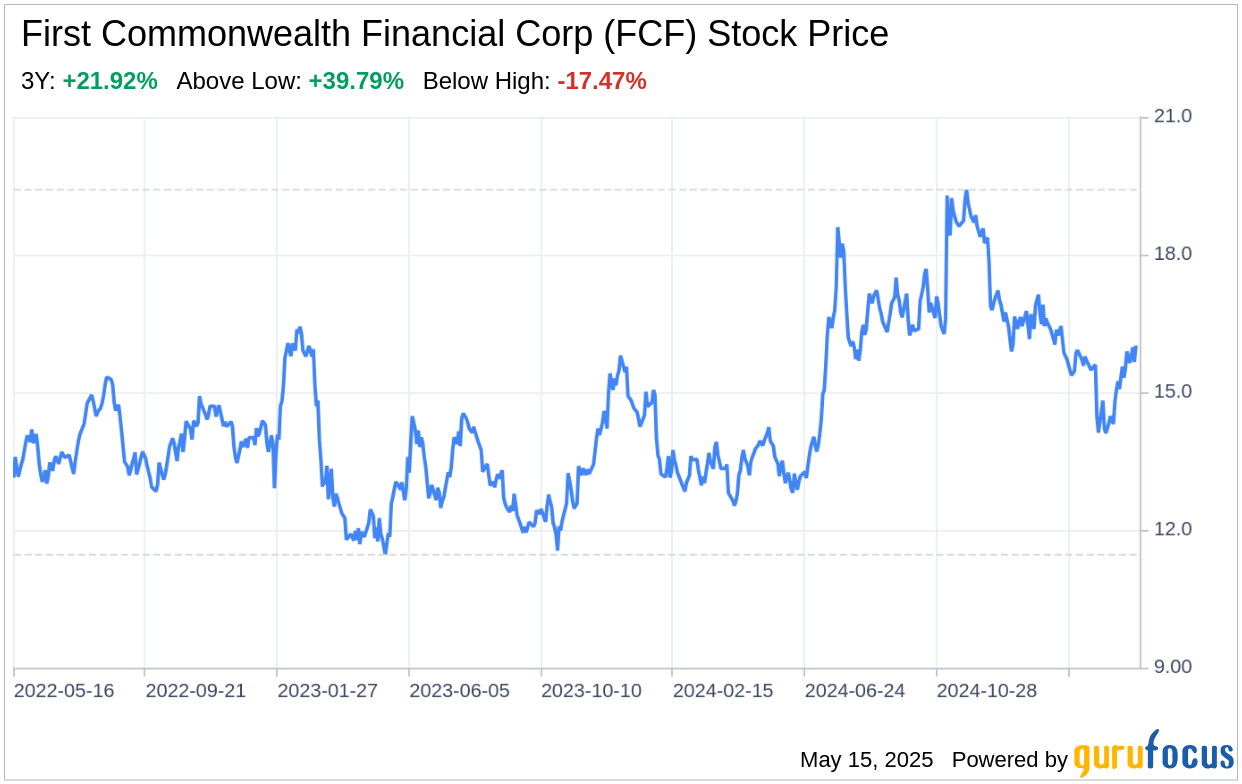First Commonwealth Financial Corp (FCF, Financial), a financial services provider in the United States, recently released its 10-Q filing for the quarter ended March 31, 2025. This SWOT analysis delves into the company's financial performance and strategic positioning. FCF reported a net interest income of $95.5 million, an increase from the previous year's $92.3 million, showcasing its ability to generate revenue from its core banking operations. However, net income saw a slight decrease to $32.7 million from $37.5 million in the same quarter of the previous year. This analysis aims to provide investors with a comprehensive understanding of FCF's strengths, weaknesses, opportunities, and threats as they consider the company's investment potential.

Strengths
Robust Net Interest Income Growth: FCF's net interest income has shown resilience and growth, increasing to $95.5 million in Q1 2025 from $92.3 million in Q1 2024. This growth indicates a strong interest-earning asset base and effective interest income management strategies. The company's ability to maintain a positive interest income trajectory in a competitive banking environment is a testament to its strong financial fundamentals and prudent asset-liability management.
Capital Adequacy: FCF maintains a well-capitalized status, with shareholders' equity reaching $1.4 billion, an increase from the previous quarter. This strong capital base positions FCF favorably in terms of regulatory compliance and provides a buffer against potential financial shocks. The company's capital adequacy ensures investor confidence and provides the financial flexibility to pursue growth opportunities.
Comprehensive Financial Services: FCF offers a diverse range of consumer and commercial banking services, including trust and wealth management, which contribute to a stable revenue stream. The company's ability to provide a one-stop financial solution enhances customer retention and attracts new clients, strengthening its market position.
Weaknesses
Decline in Net Income: The decrease in net income to $32.7 million in Q1 2025 from $37.5 million in Q1 2024 raises concerns about the company's profitability. This decline may be attributed to increased noninterest expenses and a higher provision for credit losses, signaling potential inefficiencies in cost management and risk assessment practices. FCF needs to address these issues to improve its bottom line and shareholder returns.
Noninterest Income Volatility: FCF experienced a decrease in noninterest income, which fell to $22.5 million in Q1 2025 from $23.9 million in Q1 2024. This volatility in noninterest income streams, such as service charges and card-related interchange income, could impact the company's overall revenue stability. Diversifying and strengthening noninterest income sources will be crucial for FCF to mitigate this weakness.
Operational Cost Management: The increase in noninterest expenses to $71.2 million in Q1 2025 from $65.5 million in Q1 2024 suggests rising operational costs. FCF must focus on optimizing its operational efficiency to control expenses and enhance profitability.
Opportunities
Technological Advancements: The financial industry's ongoing digital transformation presents FCF with opportunities to innovate its service delivery. Investing in technology to improve customer experience, such as mobile banking and online platforms, can attract tech-savvy customers and reduce operational costs through automation.
Market Expansion: FCF has the opportunity to expand its market presence by exploring underserved regions or acquiring smaller financial institutions. Strategic expansion can lead to a broader customer base and increased market share.
Product and Service Diversification: Developing new financial products and services, particularly in wealth management and insurance, can provide FCF with additional revenue streams. Tailoring offerings to meet specific customer needs can also enhance customer loyalty and competitive advantage.
Threats
Interest Rate Fluctuations: As a financial institution, FCF is susceptible to interest rate risks. Changes in interest rates can affect the company's net interest margin and profitability. Effective interest rate risk management strategies are essential to mitigate this threat.
Regulatory Changes: The financial sector is highly regulated, and any changes in banking regulations can have significant implications for FCF's operations. Staying compliant and adapting to new regulatory requirements is crucial to avoid penalties and maintain operational integrity.
Competitive Pressure: The banking industry is highly competitive, with numerous players vying for market share. FCF must continuously innovate and improve its offerings to stay ahead of competitors and retain its customer base.
In conclusion, First Commonwealth Financial Corp (FCF, Financial) exhibits a strong financial foundation with a growing net interest income and a well-capitalized status. However, the company faces challenges in managing operational costs and noninterest income volatility. Opportunities for growth lie in technological advancements, market expansion, and product diversification. FCF must also navigate threats from interest rate fluctuations, regulatory changes, and competitive pressures. By leveraging its strengths and addressing its weaknesses, FCF can capitalize on opportunities and mitigate threats to maintain a competitive edge in the financial services sector.
This article, generated by GuruFocus, is designed to provide general insights and is not tailored financial advice. Our commentary is rooted in historical data and analyst projections, utilizing an impartial methodology, and is not intended to serve as specific investment guidance. It does not formulate a recommendation to purchase or divest any stock and does not consider individual investment objectives or financial circumstances. Our objective is to deliver long-term, fundamental data-driven analysis. Be aware that our analysis might not incorporate the most recent, price-sensitive company announcements or qualitative information. GuruFocus holds no position in the stocks mentioned herein.
